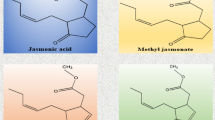Abstract.
The extension rate of the first inflorescence node of Arabidopsis was measured during light/dark or continuous light exposure and was found to exhibit oscillations which showed a circadian rhythmicity. Decapitation induced a strong inhibition of stem extension. Subsequent application of IAA restored growth and the associated extension–rate oscillations. In addition, IAA treatments, after decapitation, re-established the circadian rhythmicity visible in the intact plants during free run. This indicates that the upper zone of the inflorescence has a major influence on the extension rate of floral stems and implies a role for auxin. Application of N-(1-naphthyl)phthalamic acid, an IAA transport inhibitor, to an intact floral stem inhibited growth and the rhythmicity in the extension rate oscillations, indicating that IAA polar transport may play a role in the dynamics of stem elongation. Furthermore, IAA-aspartate application, after decapitation, did not restore growth and rhythmicity. Nevertheless, biochemical analysis of IAA and IAA-aspartate demonstrated circadian fluctuations of the endogenous levels of both compounds. These observations suggest that IAA metabolism is an essential factor in the regulation of the circadian growth rhythm of Arabidopsis floral stems.
Similar content being viewed by others
Author information
Authors and Affiliations
Additional information
Received: 21 September 1998 / Accepted: 23 January 1999
Rights and permissions
About this article
Cite this article
Jouve, L., Gaspar, T., Kevers, C. et al. Involvement of indole-3-acetic acid in the circadian growth of the first internode of Arabidopsis . Planta 209, 136–142 (1999). https://doi.org/10.1007/s004250050615
Issue Date:
DOI: https://doi.org/10.1007/s004250050615




